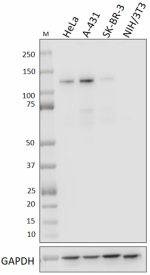- Clone
- W18281B (See other available formats)
- Regulatory Status
- RUO
- Other Names
- Transforming acidic coiled-coil containing protein 3 , ERIC1
- Isotype
- Rat IgG2a, κ
- Ave. Rating
- Submit a Review
- Product Citations
- publications

-

Whole cell extracts (15 µg total protein) from the indicated cells were resolved by 4-12% Bis-Tris gel electrophoresis, transferred to a PVDF membrane, and probed with 0.25 μg/mL (1:2000 dilution) of purified anti-TACC3 antibody (clone W18281B) overnight at 4°C. Proteins were visualized by chemiluminescence detection using HRP goat anti-rat IgG antibody (Cat. No. 405405) at a 1:3000 dilution. Direct-Blot™ HRP anti-GAPDH antibody (Cat. No. 607904) was used as a loading control at a 1:50000 dilution (lower). Lane M: Molecular weight marker -

ICC staining of purified anti-TACC3 antibody (clone W18281B) on A-431 cells. The cells were fixed with 4% paraformaldehyde, permeabilized with Triton X-100, and blocked with 5% FBS for 60 minutes. Cells were then intracellularly stained with no primary antibody (panel A) or 1.25 µg/mL purified anti-TACC3 antibody (clone W18281B) (panel B) overnight at 4°C, followed by incubation with Alexa Fluor® 594 goat anti-rat IgG (Cat. No. 405422) at 2.0 µg/mL. Nuclei were counterstained with DAPI and the image was captured with a 60X objective.
| Cat # | Size | Price | Quantity Check Availability | Save | ||
|---|---|---|---|---|---|---|
| 949401 | 25 µg | 95€ | ||||
| 949402 | 100 µg | 235€ | ||||
TACC3, also referred to as transforming acidic coiled-coil containing protein 3 or ERIC1, is involved in the process of mitotic spindle assembly and stabilization. TACC3 forms a complex with ch-TOG/clathrin to stabilize the kinetochore fibers of the mitotic spindle. It acts as an inter-microtubule bridge and maintains kinetochore tension. TACC3 is frequently overexpressed in many cancers and may serve as a therapeutic and prognostic marker in breast cancer. Multiple solid tumors have been described where TACC3 is found as a fusion with various FGFR family members, which results in constitutive receptor tyrosine kinase activity of the FGFR partner.
Product DetailsProduct Details
- Verified Reactivity
- Human
- Antibody Type
- Monoclonal
- Host Species
- Rat
- Immunogen
- Partial recombinant human TACC3 protein
- Formulation
- Phosphate-buffered solution, pH 7.2, containing 0.09% sodium azide
- Preparation
- The antibody was purified by affinity chromatography.
- Concentration
- 0.5 mg/mL
- Storage & Handling
- The antibody solution should be stored undiluted between 2°C and 8°C.
- Application
-
WB - Quality tested
ICC - Verified - Recommended Usage
-
Each lot of this antibody is quality control tested by western blotting. For western blotting, the suggested use of this reagent is 0.25 - 1.0 µg/mL. For immunocytochemistry, a concentration range of 1.25 - 5.0 μg/mL is recommended. It is recommended that the reagent be titrated for optimal performance for each application.
- Application Notes
-
This clone was tested for ICC using HeLa cells fixed with methanol or 4% paraformaldehyde and permeabilized with either methanol or Triton X-100. All three methods were compatible with TACC3 staining.
- RRID
-
AB_2910516 (BioLegend Cat. No. 949401)
AB_2910516 (BioLegend Cat. No. 949402)
Antigen Details
- Structure
- TACC3 is an 838 amino acid protein with a predicted molecular weight of 90 kD.
- Distribution
-
Ubiquitously expressed/cytoplasm and mitotic spindle assembly
- Function
- Cell cycle, cell division, mitosis, differentiation
- Biology Area
- Cell Biology
- Molecular Family
- Microtubules
- Antigen References
-
- Gangisetty, et al. 2004. Oncogene. 23:2559.
- Costa R, et al. 2016. Oncotarget. 7:55924.
- Ding, et al. 2017. Cytoskeleton. 74:369.
- Huo Q, et al. 2021. Front. Genet. 12:640078.
- Gene ID
- 10460 View all products for this Gene ID
- UniProt
- View information about TACC3 on UniProt.org
Related Pages & Pathways
Pages
Related FAQs
Other Formats
View All TACC3 Reagents Request Custom Conjugation| Description | Clone | Applications |
|---|---|---|
| Purified anti-TACC3 Antibody | W18281B | WB,ICC |
Compare Data Across All Formats
This data display is provided for general comparisons between formats.
Your actual data may vary due to variations in samples, target cells, instruments and their settings, staining conditions, and other factors.
If you need assistance with selecting the best format contact our expert technical support team.
 Login / Register
Login / Register 









Follow Us